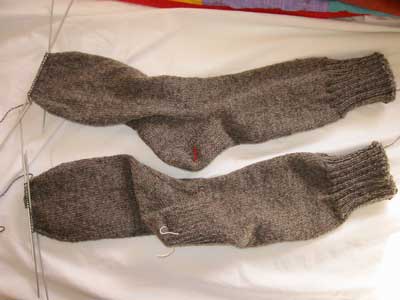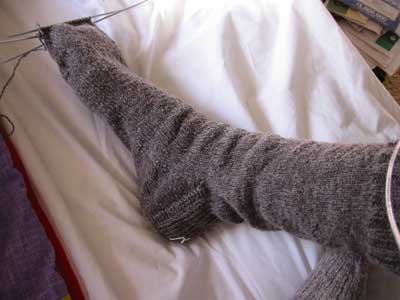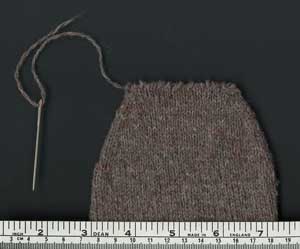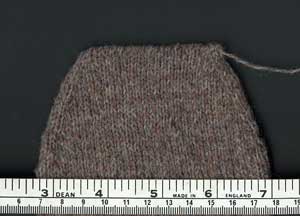A lot has happened since Friday . I took a break for a migraine, the holiday, and a visit from my sister. The body of the older of the two drowned sisters was recovered from the Milwaukee River at the Wisconsin Avenue bridge (the one with the Gertie the Duck sculpture, a neighborhood landmark) on Monday, Memorial Day.

The toe is probably the best comfort reason to hand knit your socks because instead of having a seam over your toes, the sock is knit smoothly with decreases on either side of the foot. The opening at the tip of the toe is woven together, also called grafting or Kitchener stitch.

If you haven't tried on the sock, this is the perfect time. If the foot of the sock is too long or short, you can calculate what you need, rip the stitches, and re-knit the toe to fit. This sock is way too loose for my foot (unless the intention is to shrink and felt it) but I am knitting it for someone else. Instead, I fold the sock at the heel and lay the sole over the outline I traced, and it fits.
If you get to this point and don't have an even number of stitches, either rip and correct the mistake, or make one extra decrease. You need the same number of stitches on the top half and sole half.
I am down to 40 stitches around on each sock. I knit across the 10 stitches on the left sole needle for 20 stitches on each of two needles to weave together. This is a rather blunt toe, but it fits the tracing. As a result, it won't lie flat when folded sideways, but it is more important to fit the foot than the sock drawer.

Now, I break the yarn leaving a generous end, about a foot and a half long, and thread the end through a needle. I turn the work so that the end with the thread is to the right, then get into the rhythm - on front needle knit and slip off, perl and leave on, on back needle perl and slip off, knit and leave on, font needle... repeated across until only one front needle and one back needle stitch is left. It isn't necessary to make the weaving tight. It is more important to go for accuracy.

It is fairly easy to adjust the tension after the weaving is done.

The knitting is now done, but the socks are not quite ready to wear. I only have four ends to bind in, where I cast on and the end I just left on each toe. Had I had to join on yarn, I would bind the ends tracing the path of the row on either end using tapestry needle. Leave about a quarter inch or so of yarn on the inside when binding in. If you cut it too short, it can pop through to the right side and look untidy. The end will tend to fray and cling to the wool on the stitches. Remember to avoid knots as they can cause problems.
Tomorrow I will wash and block the socks.